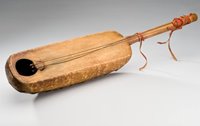 |
 |
||||||
|
|||||||
|
|||||||
 The
xalam is the most common stringed musical instrument in Gambia. Griots
of many ethnic groups play it, including
the Wolof, Serer, Mandinka, Fulbe, and Tukulor. It probably came from
the Bamana of Mali through several different paths. The
xalam is the most common stringed musical instrument in Gambia. Griots
of many ethnic groups play it, including
the Wolof, Serer, Mandinka, Fulbe, and Tukulor. It probably came from
the Bamana of Mali through several different paths.The Bamana passed it on to the Malinke in the south and to the Tukulor and Fulbe in the north, and these groups passed it on in separate waves to the Wolof and Serer. Because of the variety of paths the xalam has taken and the many different groups who have embraced it, the xalam shows great regional diversity in its construction, playing style, and repertoire. It generally has a dryer, more nasal sound than the Kora. The xalam was formerly played primarily as a solo instrument or to accompany songs, although today it is often amplified to allow it to play alongside sabars, Djembes, koras, and other instruments. In Wolof-speaking areas in Gambia, people who play the xalam are often called jeli, which comes from the Bamana word for griots. Fulbe xalam players are often called bambaado. The xalam has a wooden body and neck and a cowhide face. Its fishing-line strings are fastened to the neck by long cowhide straps. There are two melody strings and between 2 and 4 supplementary octave strings. Most xalams have 4 to 5 total strings, although some have up to 8. The player fingers the neck with the left hand, as with the Western guitar, and plucks the strings with the thumb and index finger of the right hand. The left hand only fingers the two melody strings, and the others are only plucked like a harp. Sometimes the octave strings are referred to as the "kora strings," since they could be strummed to imitate a kora, or harp-lute. In traditional contexts, the xalam is most often used to accompany spoken and sung histories and praise songs. Often, one griot plays a repeated motif while another tells a story, pausing from time to time to allow the xalam player to improvise. In Mande societies (Mandinka, Malinke, Bamana), the xalam may be accompanied by a Kora or Balafon (xylophone). In many places, xalam players are considered to be the greatest griots and were in former times an important part of the royal courts. Today, xalams are often included in popular and semi-traditional music groups. They are much more prevalent in Gambian popular music than the Kora, and many groups have up to three or four xalam players. Every region has its preferred tunings, although a few have become standard throughout Gambia. Assuming, for convenience, that the xalam's tuning is based on the key of C (although in practice a player can tune it to any pitch), here are a few of the more common tunings, represented as a close-up of the lower part of the neck. Although there are many xalam players in Gambia and Senegal today, many people believe that the tradition of great playing is dying out. A group of "Great Griots" that formed after independence to support the Senegalese Socialist Party included several legendary griots, most of whom are no longer living and have left no successors. The Gambians also compare their xalam players to Malian xalam (ngoni) players like Banzoumana Cissokho, who is reputed to have been such an expert player that he could get up and leave the room and his xalam would continue 'playing' without him. Legendary xalam players Ama Ndiaye Samb, Abdoulaye Nar Samb, and Abdoulaye Socé (the father of my xalam teacher, Malick Socé) have all died. The only xalam player left from this group is Samba Diabaré Samb, who is the only one from his family to play the xalam. Boucounta Ndiaye, who is a bit younger than Samb, is the closest anyone has come to rivalling the old group in greatness. |
|||||||
| Site Map | |||||||
|
|||||||